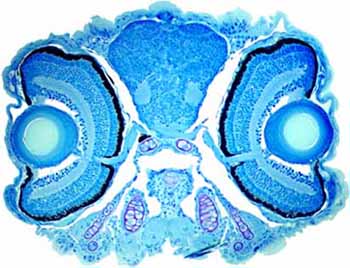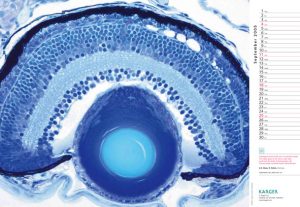Zebrafish models of human disease

Section through a larval zebrafish revealing the two very large eyes. Note that their morphology is very similar to that of a human eye. Copyright: Ralf Dahm, Max Planck Institute for Developmental Biology, Tübingen, Germany.
Why study fish when you want to understand how humans develop and how genes can cause disease? Well, even though zebrafish look nothing like humans, their embryonic development is controlled by much the same genes as ours and defects (mutations) in their genes can lead to diseases that closely resemble human pathologies. Understanding the functions of these genes through studies with fish therefore tells us a lot about they do in humans.
Moreover, zebrafish are not as different from us as it may appear at first glance. Take the eye, for instance. Vision is very important for both us and zebrafish. The latter becomes obvious from the sheer size of the eyes in zebrafish larvae where they are the biggest structure in the body. And their structure is very similar to that of our eyes.
These similarities with humans make zebrafish an attractive model to study human diseases caused by genetic defect.
 This picture shows a section through the eye of a zebrafish larva. The fish shown here harbours a genetic defect (mutation) that results in the death of the light-sensitive photoreceptor cells in the retina. This condition resembles a human disease, macula degeneration, which is still impossible to cure. The hope is that research on zebrafish, among other models, will uncover the genetic defects that can lead to the disease and may thus help to develop new treatments. This image was included in the 2005 calendar of the Swiss publishing house Karger. Copyright: Anne S. Glass and Ralf Dahm, Max Planck Institute for Developmental Biology, Tübingen, Germany.
This picture shows a section through the eye of a zebrafish larva. The fish shown here harbours a genetic defect (mutation) that results in the death of the light-sensitive photoreceptor cells in the retina. This condition resembles a human disease, macula degeneration, which is still impossible to cure. The hope is that research on zebrafish, among other models, will uncover the genetic defects that can lead to the disease and may thus help to develop new treatments. This image was included in the 2005 calendar of the Swiss publishing house Karger. Copyright: Anne S. Glass and Ralf Dahm, Max Planck Institute for Developmental Biology, Tübingen, Germany.